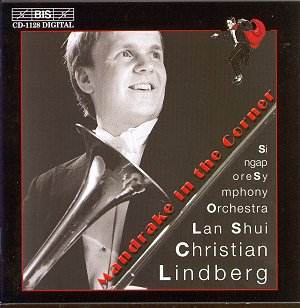Last year
I reviewed a BIS release of works primarily for trombone ensemble
that included Christian Lindberg’s own "concerto", Mandrake
in the Corner. Here, the same recording with the Singapore Symphony
Orchestra resurfaces, this time packaged in the more likely context
of three other concertos in all but name, by Scandinavian composers
ranging from the little known Dane Axel Jørgensen to Jan Sandström,
a close friend of Lindberg with whom he has enjoyed a particularly fruitful
relationship.
Mandrake in the Corner is only Lindberg’s second
serious attempt at composition. His first piece Arabienne, being
included on the aforementioned earlier BIS release. The title Mandrake
in the Corner, taken from a comic book figure, Mandrake the
Magician, came only after composition was well advanced, springing from
what I described in my previous review as the "action adventure
film" character of the music and what the composer himself thinks
of, perhaps rather modestly, as a reminder of a "second rate TV
thriller". It certainly has a somewhat garish feel to it, rhythmically
dramatic in the first movement and slightly sleazy in the central section
of the second, conjuring images of dubious, smoke filled bars in American
gangster films. The final Vivace is a manic, hell for leather
dash for the finishing post with just the one brief point of repose,
revisiting material from the opening movement, before the driving concluding
bars.
In his booklet notes on the piece Christian Lindberg
tells of his indignation at a critic’s dressing down of Axel Jørgensen’s
Suite for Trombone and Orchestra after he first played the work
at a public concert. Jørgensen’s amateur status as a composer
(he spent most of his career as an orchestral musician) was such that
his music was little heard even in his own lifetime although this suite,
whilst melodically unmemorable, is not without its moments of interest.
Overall though I was left with a feeling similar to that of having listened
to one of the legion of British brass band works written in the 1920s
and onwards, by composers whose names have long since been forgotten.
Namely, unexcited and underwhelmed.
In contrast, Egil Hovland is a composer I would like
to hear more of. Written in the early 70s after his music had undergone
a period of experimentation, his Concerto for Trombone and Orchestra
is a highly virtuosic, stamina-sapping showpiece that even by today’s
standards is still a work of daunting technical difficulty. Born in
Oslo in 1924, Hovland studied with Vagn Holmboe, Copland and Dallapiccola
and has not been without significant success, his Music for Ten Instruments
winning the Koussevitsky prize in 1957. The Trombone Concerto
has a bracing Nordic spirit about it although, if anything, the opening
of the first movement strikes me as being closer to Shostakovich than
anything else. As you would expect, Lindberg takes the technical demands
of the work in his stride (try the first movement cadenza from around
6’30" for both lyrical control and clarity of articulation) although
in many ways it is the hauntingly nocturnal central slow movement that
I found most affecting.
Not for the first time, Jan Sandström has here
created a condensed version of his Trombone Concerto No. 2, "Don
Quixote" in Cantos de la Mancha, having carried out
a similar exercise with his earlier "Motorbike Concerto"
into the eight minute A Short Ride on a Motorbike (both of the
full works are available on another BIS disc, BIS-CD-828). In terms
of sheer inventiveness of imagination Cantos de la Mancha stands
apart from every other work on the disc. Combining a multitude of effects,
extended technical feats and vocal exclamations, the work is broken
down into five relatively brief movements, four of which take as their
starting points episodes from Quixote’s colourful exploits with the
subtitles "To walk where the bold man makes a halt", "To
row against a rushing stream", "To believe in an insane dream"
and "To smile despite unbearable pain". From the opening fanfare
and nonsensical vocal expostulations of the introduction the movements
progress through playful rhythmic irregularity, glowing serenity and
Messiaenic like outbursts to the anguished calm of the closing paragraphs
as Sancho Panza witnesses his master, beaten and bloody on the ground.
Lindberg responds to this tour de force of virtuosity with playing of
stunning facility, not to mention theatrical showmanship and as a result
it is the works by Sandström and Hovland that make this disc truly
worthwhile.
The Singapore Symphony Orchestra under the guidance
of Lan Shui provide competent accompaniment and as can be relied upon
from BIS, the recordings are both dynamic and realistic.
Christopher Thomas.


